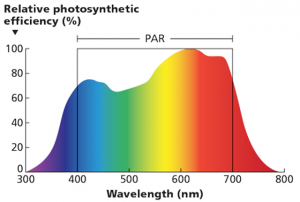The objective for assignment 1:3 is to identify the importance of definitions and tailoring it to the intended audience with the right level of detail.
Term and situation
The term I will be defining is photosynthetically active radiation (PAR). In this recent scenario, I am trying to convey to an engineering physic student with interest in biology the theory behind measuring PAR. The student have high school biology and physics background that can understand how plants perform photosynthesis and knowledge in the electromagnetic spectrum.
Parenthetical definition
Parenthetical definition is used in situation where a quick definition can be provided. For example: Photosynthetically active radiation (sunlight that can be harvested by plants) can vary in intensity throughout the day.
Sentence definition
Photosynthetically active radiation is a fraction of the total incident solar radiation that has a wavelength between 400 nanometer and 700 nanometer, measured in irradiance (W/m^2). Radiation in this range is characterized by its ability to be captured by plants to perform photosynthesis.
Expanded definition
The term photosynthetically active radiation (PAR) can be broken into two physically meaningful parts. Photosynthetically active indicates that the radiation is able to be captured by chlorophyll (cells that can absorb the sunlight) in the plant (Session, 1998). This captured energy will be used by the plant to perform photosynthesis. Radiation in this context is a form of energy that only travels as an electromagnetic wave.
PAR works by providing the energy to be used by the plant to drive the photosynthetic reaction involving water (uptake through the plant’s roots) and carbon dioxide (uptake through the plant’s stomata) to create sugar for the plant.
PAR is not the same as sunlight in the visible spectrum. PAR occupies in a narrower electromagnetic range in the visible spectrum as absorbing radiation above 700nm in wavelength might damage the plant’s biomass, similar to human getting sun burned. Therefore not the entire visible spectrum 300nm to 800nm will need to be measured by the spectral sensor and we can only focus on 400nm to 700nm range.

Figure 1. Image of the PAR range occupancy in the visible section of the electromagnetic spectrum. Courtesy of Jill Whitehead.
Data collected from measuring PAR can be used to calculate varies different metrics such as the theoretical productivity of the ecosystem assuming the plants are not water or nutrition limited (Session, 1998). PAR can also show photosynthetic efficiency when compared with field based photosynthetic measurement (Frouin, 1995).
References
Frouin, Robert, and Rachel T. Pinker. “Estimating photosynthetically active radiation (PAR) at the earth’s surface from satellite observations.” Remote Sensing of Environment 51.1 (1995): 98-107.
Session, V. “Photosynthetically Active Radiation (PAR) Measurements and Their Use in Forest Health Monitoring.” on Air Pollution and Climate Change Effects on Forest Ecosystems (1998): 321.
Whitehead, J. (2019, June 6). Plant morphology and spectrum: How plants respond to light quality. Retrieved from http://pllight.com/plant-morphology-and-spectrum-how-plants-respond-to-light-quality/